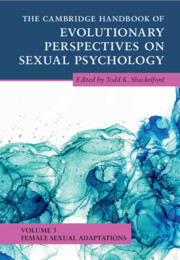Book contents
- The Cambridge Handbook of Evolutionary Perspectives on Sexual Psychology
- The Cambridge Handbook of Evolutionary Perspectives on Sexual Psychology
- Copyright page
- Contents
- Contributors
- Preface
- Part I Precopulatory Adaptations
- Part II Copulatory Adaptations
- Part III Postcopulatory Adaptations
- 13 Mate Retention
- 14 Shifts in Partner Attractiveness
- 15 Emotional Commitment
- 16 Female Sexual Jealousy
- 17 On Attachment and Evolution: Recounting the Story of, and Stories in, Attachment Theory
- 18 Maternal Filicide
- Index
- References
16 - Female Sexual Jealousy
from Part III - Postcopulatory Adaptations
Published online by Cambridge University Press: 30 June 2022
- The Cambridge Handbook of Evolutionary Perspectives on Sexual Psychology
- The Cambridge Handbook of Evolutionary Perspectives on Sexual Psychology
- Copyright page
- Contents
- Contributors
- Preface
- Part I Precopulatory Adaptations
- Part II Copulatory Adaptations
- Part III Postcopulatory Adaptations
- 13 Mate Retention
- 14 Shifts in Partner Attractiveness
- 15 Emotional Commitment
- 16 Female Sexual Jealousy
- 17 On Attachment and Evolution: Recounting the Story of, and Stories in, Attachment Theory
- 18 Maternal Filicide
- Index
- References
Summary
In this chapter we summarize and discuss the literature on human female romantic jealousy from an evolutionary perspective. We first define jealousy as a complex cognitive, affective, and motivational state that occurs in response to the threatened or actual loss of a valued relationship to a rival, and that can trigger different emotions. We further discuss different dimensions of jealousy, stressing both state and trait jealousy. We outline behavioral consequences of jealousy, such as mate guarding and mate retention, and we discuss how some qualities of rivals can trigger jealousy. The most frequently studied area in research on human jealousy is sex differences in sexual versus emotional jealousy, suggesting a robust and replicated finding of higher emotional jealousy in women, and higher sexual jealousy in men. We further discuss individual differences that explain variation in jealousy, such as higher overall jealousy among women, associations between women’s jealousy and their anxiety and self-esteem, developmental factors influencing jealousy, lower jealousy among non-monogamous individuals, and high jealousy among pathologically jealous individuals. We challenge the research on sex differences in jealousy with reference to intra-sexual variation among individuals of different sexual orientations. We show that female jealousy is influenced by hormonal and genetic factors, and we discuss examples of non-human species to show analogies to human jealousy. Throughout the chapter we stress the plasticity of jealous response depending on contextual factors, including environmental and sociocultural contexts. Human diversity in the manifestations of state jealousy does not contradict the evolved nature of jealousness. We conclude by considering the distal functions of jealousy, including maintenance of a valued relationship and self-esteem, mate-poaching, and mate-switching. We note several gaps in the literature of female jealousy, and we hope this chapter integrates the literature, informs newcomers, and inspires new evolutionary research.
- Type
- Chapter
- Information
- Publisher: Cambridge University PressPrint publication year: 2022



